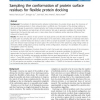Free Online Productivity Tools
i2Speak
i2Symbol
i2OCR
iTex2Img
iWeb2Print
iWeb2Shot
i2Type
iPdf2Split
iPdf2Merge
i2Bopomofo
i2Arabic
i2Style
i2Image
i2PDF
iLatex2Rtf
Sci2ools
BMCBI
2010
2010
Sampling the conformation of protein surface residues for flexible protein docking
Background: The problem of determining the physical conformation of a protein dimer, given the structures of the two interacting proteins in their unbound state, is a difficult one. The location of the docking interface is determined largely by geometric complementarity, but finding complementary geometry is complicated by the flexibility of the backbone and side-chains of both proteins. We seek to generate candidates for docking that approximate the bound state well, even in cases where there is backbone and/or side-chain difference from unbound to bound states. Results: We divide the surfaces of each protein into local patches and describe the effect of side-chain flexibility on each patch by sampling the space of conformations of its side-chains. Likely positions of individual side-chains are given by a rotamer library; this library is used to derive a sample of possible mutual conformations within the patch. We enforce broad coverage of torsion space. We control the size of the sa...
BMCBI 2007 | BMCBI 2010 | Bound State | Protein | Protein Dimers |
| Added | 24 Dec 2010 |
| Updated | 24 Dec 2010 |
| Type | Journal |
| Year | 2010 |
| Where | BMCBI |
| Authors | Patricia Francis-Lyon, Shengyin Gu, Joel Hass, Nina Amenta, Patrice Koehl |
Comments (0)

